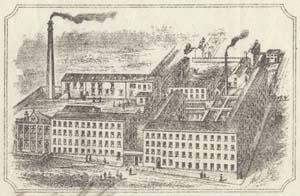
|
Manufacturing - TextilesOne of the localised specialities in Staffordshire was the textile industry, which tended to flourish in valleys with a good supply of water power. There was a particular prevalence of it in the southern Moorlands, following the River Churnet, with Leek’s silk trade, and by the Rivers Dove and Tean, with cotton-spinning at Tutbury, and ribbonware and other narrow fabrics produced at Cheadle and Tean. Cotton-weaving was common as a cottage-based industry in south-eastern Staffordshire, around the Trent Valley, and factories were built at both Burton on Trent and Fazeley by the Peel family. Leek was pre-eminent in the county for both silk-weaving and silk-dyeing. This was encouraged in the mid-eighteenth century, by improved communications from the newly turnpiked roads, and, at the end of the century by the building of a new branch of the Cauldon Canal. This gave easy access to the quantities of fuel from the Potteries to drive new, steam-powered silk mills. The primary stages of the silk textile industry were to process the raw material, and twist it into a fine or strong thread. This was done using a wheel in a silk shed or “shade”, with the empty and full bobbins being carried by boys. Silk thread would then be dyed and then either sold as sewing thread or woven into finished fabrics such as ribbons, handkerchiefs and shawls, or also further twisted and stitched to make items such as buttons. The weaving of cotton or linen ribbons and tapes provided a cheaper and more hard-wearing option than silk, with bleaching being an important part of the process. In more recent years the “narrow-fabric” factories of Tean became very specialised and made woven products, such as heavy-duty belts, for modern industrialised industries. As with other manufacturing industries, workers would become very specialised in particular parts of a craft. But, as with other specialisms, this meant that it was harder to find work when times were bad. The textile industry was one of the first to be affected during a depression as people cut down on their purchases, whether for basic necessities or luxuries. A new regime of factory inspection in the 1830s also regulated the number of hours that could be worked by children. |
